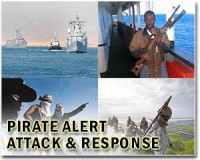| . |  |
. |
Mogadishu, Somalia (UPI) Nov 19, 2009 China has sent a new navy flotilla to join an international fleet in the Gulf of Aden combating increasingly bold Somali pirates who are pushing deeper into the Indian Ocean as merchant vessels start to fight back against them. One of the missions of the incoming flotilla, the fourth Beijing has rotated into the region since it joined the anti-piracy campaign in December, will be to locate 25 crewmen of the bulk carrier De Xin Hai captured Oct. 19. The Chinese have vowed an all-out effort to rescue their countrymen. The flotilla comprising the missile frigates Ma'anshan and Wenzhou recently joined the European-led fleet and hooked up with the supply ship Qiandaohu, which has been on station since June. Both frigates carry a helicopter and a detachment of special forces troops, who presumably could be used for a raid to rescue the hostages now held on land. A successful rescue operation -- more difficult on land than at sea -- could deter pirates targeting Chinese-flagged vessels in the future. After U.S. Navy SEALs rescued the kidnapped captain of the U.S.-flagged Maersk Alabama in April and killed three pirates, no other American vessel came under attack until Wednesday. As fate would have it, the ship that was hit was again the Maersk Alabama, this time 350 nautical miles east of Somalia. But on this occasion, the crew, bolstered by an armed four-man security detachment, drove off the pirates who were firing from a speedboat. That's the first time that a major cargo shipping line has used gunfire to deter pirates, and it could encourage other owners to follow suit. The 41,000-ton Di Xin Hai, carrying 76,000 tons of coal, was hijacked north of the Seychelles Islands in the western Indian Ocean about 700 nautical miles east of Somalia. That seizure was one of the first pirate attacks following a three-month lull during the annual monsoon that sweeps the Indian Ocean with heavy storms. It underlined the extent to which the pirates are now roaming further afield from their usual operational zone off the Somali coast, using seagoing mother ships to mount increasingly bold attacks on merchant vessels with armed speedboats. The pirates' expansion of their hunting ground eastward into the Indian Ocean and northeast up to the Gulf of Oman, where shipping lanes are crowded with tankers and freighters moving in and out of the Persian Gulf, has stretched the international fleet's resources to the limit. The naval task force comprises some 25 warships from 14 nations, among them members of the European Union, the United States, Russia and India. The EU's primary mission is to escort cargo ships carrying food aid to East Africa. These vessels have clashed with pirates several times, but the modern-day buccaneers remain undeterred. They racked up an estimated $80 million in ransoms in 2008. They were undoubtedly encouraged by the payment Tuesday of a $3.3 million ransom by Madrid for the release of the Spanish tuna trawler Alakrana and her 36 crewmen, hijacked Oct. 2, one of the first seizures after the monsoons abated. A helicopter aboard one of the two Spanish warships operating in the area fired on the pirates as they fled from the Alakrana, but they escaped and reached land. The Alakrana was also hijacked off the Seychelles 350 nautical miles northwest of the main island of Mahe. The incident triggered a political dispute when the Madrid government refused to allow armed guards aboard Spanish trawlers in the Indian Ocean. Madrid relented after it was learned that the French had placed marines on some of their fishing boats and had successfully beaten off pirate attacks. As the pirates, increasingly well organized, have fanned out across the Indian Ocean, the international naval task force has begun employing unmanned aerial vehicles to detect the marauding pirates at long range. The U.S. Navy disclosed in early October as the pirate attacks increased following the end of the monsoon season that it was using MQ-9 Reaper UAVs based on land in the Seychelles. The radar-equipped drones, which can stay aloft for 16 hours, are being operated by the U.S. military's Africa Command. The UAVs can carry a dozen bombs and missiles, but as far as is known, they are not being armed for their surveillance missions. But, now that American-flagged vessels are again under attack, all that could change. Share This Article With Planet Earth
Related Links 21st Century Pirates
 Somali pirates launch longest-range attack: EU
Somali pirates launch longest-range attack: EUBrussels (AFP) Nov 9, 2009 Somali pirates have launched their deepest attack into the Indian Ocean, firing rocket propelled grenades at a Hong Kong-flagged oil tanker, the European Union anti-piracy mission said Monday. The tanker, the BW Lion, managed to escape the attackers and suffered no casualties during the incident Monday, some 400 nautical miles northeast of the Seychelles and 1,000 nautical miles east of the ... read more |
|
| The content herein, unless otherwise known to be public domain, are Copyright 1995-2009 - SpaceDaily. AFP and UPI Wire Stories are copyright Agence France-Presse and United Press International. ESA Portal Reports are copyright European Space Agency. All NASA sourced material is public domain. Additional copyrights may apply in whole or part to other bona fide parties. Advertising does not imply endorsement,agreement or approval of any opinions, statements or information provided by SpaceDaily on any Web page published or hosted by SpaceDaily. Privacy Statement |